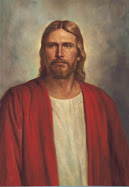Hymn #333 is the Men's Choir arrangement of the song.
This is another oft-sung hymn. Enough so that I had it memorized either by the time I got to college, or sometime in the early years of college. I first really noticed the song at a choir practice when we were living in WV. I had started to join my father, figuring, "Hey, I can sing! Who said teenagers can't be in the ward choir?" I even joined the stake choir on that premise. So I went to practice one Sunday, and the missionary I had an enormous crush on came that morning. We were very small in number. If I remember correctly, I was the only soprano. And suddenly I was extremely nervous and aware that I needed to know what I was singing if I didn't want to sound like an idiot in front of my missionary crush! I paid close attention to my notes and the words. And in the paying attention, I realized this song had a great message, and a really fun soprano part! I also noticed it had a really nice tenor part, too. ;-) It may have also stood out because another choir member said that his ancestor wrote the song. And a third reason may have been that around that time one of my favorite Church movies to watch was "Mountain of the Lord." Whatever the reasons that bring a hymn to one's knowledge and appreciation, I am all for! :-)
I don't know how to "pick apart" this hymn to say what I like. It all tells of the promises of the Lord coming about. I knew that even as an east coast girl. But now that I seem to have been relocated to Utah, I see it often whenever I go to the Salt Lake City temple. And being a huge fan of our temples, I see the song applying to all the temples--where our promised blessings come to us, where we are taught, and where we save our dead at the same time.
From the history book
The author of this hymn was baptized in 1831--only 1 year after the Church was organized. Because of mob violence, he never lived for very long in any place, and even after arriving in Utah lived in 11 new places. He was faithful and responded to his mission calls and assignments to speak. Wrote many other hymns, one other being included in the 1985 hymnal. There were two verses from the 1950 hymnal not kept in this hymnal. They were not as much about the temple as finding a refuge in Deseret (aka Utah when the Saints first settled it). It makes sense he wrote those verses, since Utah became his home and refuge after all that persecution.




No comments:
Post a Comment